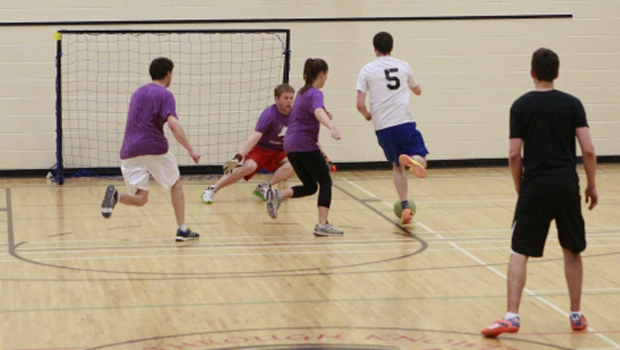
The last third of the court in Gym Soccer is where most of the excitement happens, from amazing one-two plays leading to goals being scored, to strong defensive plays that turn into great counterattacks! Although there is a lot of excitement and action there are two areas in the last third of the court that cause a lot of confusion and grief for players: Corners and Creases!
In Gym Soccer the ball is often played into the corner, and in the heat of the game both players fly after it forgetting everything they should be doing when a corner ball happens.
The official corner rule reads:
When two players are chasing the ball into the corner, the leading player must be given possession of the ball with the opponent standing at least five feet away. The opposing player must not approach for 3 seconds and must count out ‘1, 2, 3’ once the player has gained control of the ball. Teams should yell ‘corner’ to their own player, if this does not happen the GC will call it. Further clarifications:
- If a player carries the ball into the corner, the 3 second rule does not apply but all other non-contact rules apply (e.g. no body contact).
- If the ball moves into the corner from close proximity (less than 20 feet), the 3 second rule does not apply; the 3 second rule is set-up to avoid collisions when two players are running at fast speeds into the corner.
Essentially this means when the ball is played into the corner from more than 20 feet out (i.e. a defensive clear from one end to the other) both the attacking team and defensive team should turn on their jets, because the person who is in the lead about 5-10 feet from the corner will gain possession. Once possession is gained the player who didn’t get there first needs to cool the jets and remain in a stall for a minimum of 3 seconds before being able to making a play for the ball.
Then there is the crease, a controlled area surrounded by high traffic volume with a lot of things happening all at once. Creases are always marked and confirmed at the beginning of the game by a Games Coordinator. Players can think of this area kind of like the Bermuda triangle, where only the Goal Keepers can navigate and handle the ball successfully while inside it.
The official crease rules are:
- A goalie must have at least one part of their body in the crease in order to play the ball with their hands.
- No player from either team is allowed to stand inside their own, or their opponents' crease.
- Players can run through the crease as long as the goalie is not interfered with and they do not touch the ball.
- If a player is standing in the crease, it is the GC’s job to tell that player to move. If a goal is scored and the GC deems that an offensive player was interfering with the goalie, the goal will be disallowed.
- If a goal is scored by a shooter that is not in the crease while their teammate is moving through the crease and a goal is scored, it will count as long as there was no goalie interference.
- No player (with the exception of the goalie) is allowed to touch the ball while any part of their body is in the crease. This also means that no player can score from inside the crease.
- If an offensive player touches the ball while any part of their body is in the crease an indirect free kick from the edge of the crease is awarded to the defensive team
- If a defensive player touches the ball while any part of their body is in the crease, they are given a minor penalty, however their team does play short-handed for two minutes, and the offensive team is awarded a corner kick.
Essentially the crease is the goalie’s controlled air space and other players need to be very cautious and abide by certain rules while entering it. Players may enter the goalie’s air space to simply fly through, but may not land or affect the goalies flight path. Players can never be still or play the ball while in the crease, and cannot interfere with a goalie’s ability to make a play.
Fly safe while you play gym soccer and make sure you know the right-of-way rules!




























